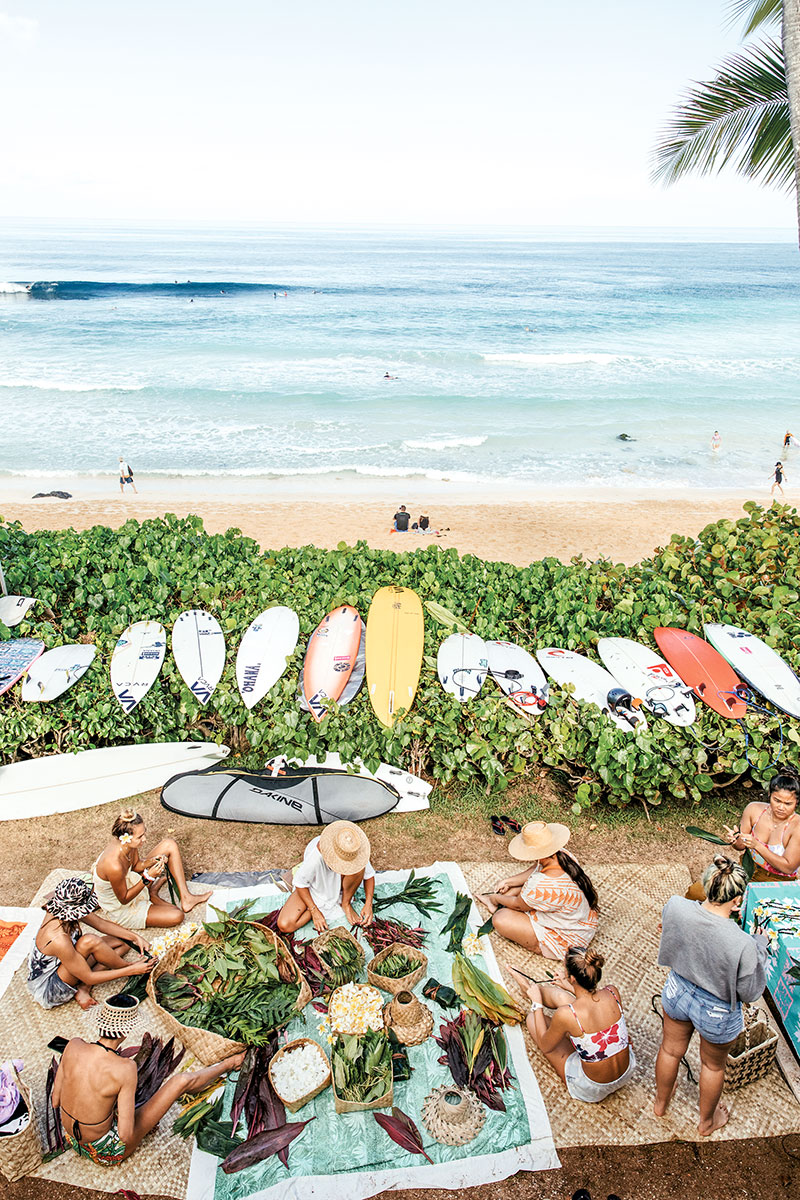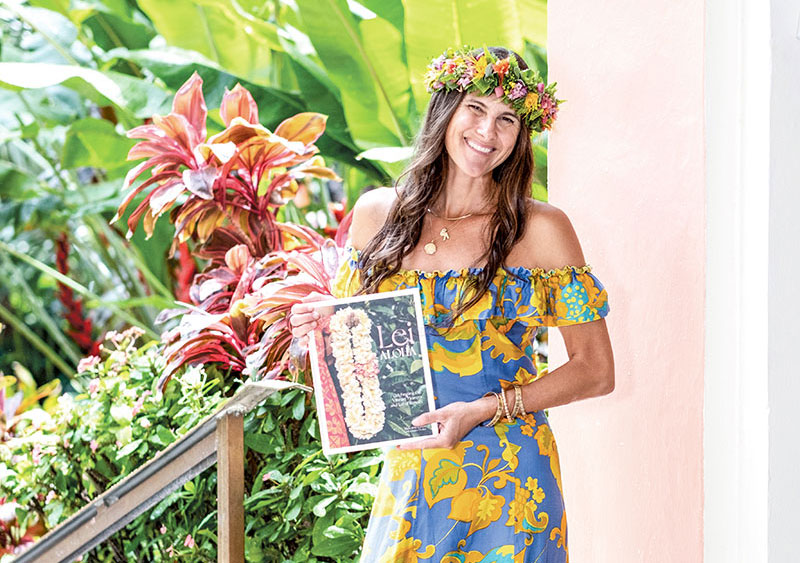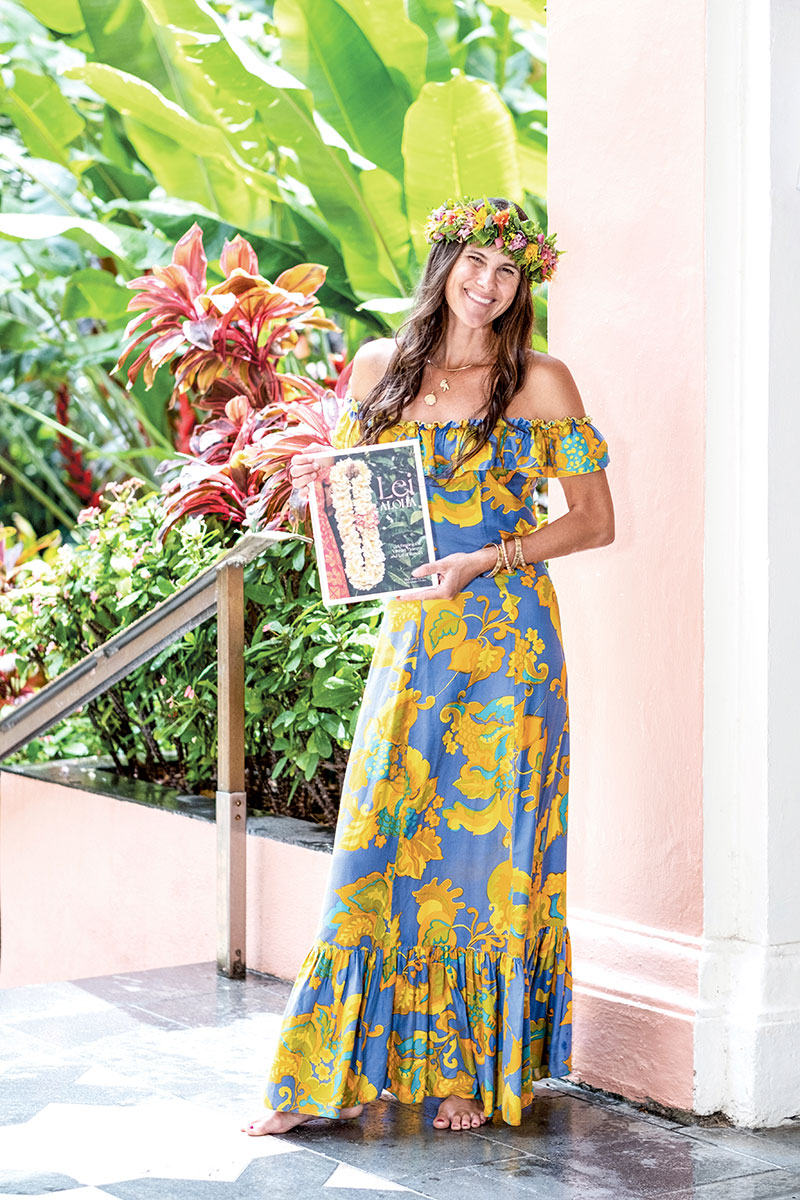In Full Bloom
Often called “the curator of modern aloha,” Meleana Estes is flourishing these days, thanks in part to a fragrant new offering: a book that celebrates the flowers and lei of the islands.
By definition, when a flower blooms, it’s in a state of beauty, freshness and vigor. It’s basking in warmth, bright in color and celebrating its moment of glory.
By comparison, Meleana Estes is in full bloom.
Hot on the heels of launching a jewelry line, Estes’ first book, Lei Aloha: Celebrating the Vibrant Flowers and Lei of Hawai‘i, debuts April 25. It’s essentially a hardcover, 256-page love letter to her tūtū, the late Amelia Ana Ka‘ōpua Bailey, a meticulous and magnificent lei maker who shared her passion and expertise with Estes, along with the love and aloha that came with it.

In Meleana Estes’ new book, the Honolulu resident explores Hawaiian culture through the art of lei making and shares the stories of the flower, craftsmanship and community of local lei culture. PHOTO COURTESY TARA ROCK
Anything worthy of a celebration warranted a lei from tūtū. At her baby lū‘au, a 1-year-old Estes donned a tilted haku that barely fit her tiny head. When her Punahou School paddling team won the championship, the entire team was dressed in lei po‘o as they gripped and lifted their oars in victory.And while attending college on the East Coast, Estes received a FedEx box on her birthday containing fresh lei that was shipped thousands of miles across the country.
“My friend who I went to college with recently reached out to me on Instagram to congratulate me on the book … and he was like, ‘I still remember the herds of you walking into graduation with haku lei on your caps,’” shares Estes. “My tūtū came and made 14 lei for my 14 best friends and, of course, puakenikeni lei for all my guy friends.
“The energy, love and devotion she had to adorn us for events was amazing,” Estes continues. “It was the way she showed aloha. It wasn’t just buying a random lei — she really cared and wrapped it in a pū‘olo. It was an event, receiving a lei from her. I’ve been told that by many people.”
In 2015, a few years following her tūtū’s passing, Estes, a fashion designer-turned-stay-at-home-mom, wanted to get back in the groove of things. That’s when a friend, Courtney Monahan, who owns Kaka‘ako-based botanical boutique Paiko, suggested she hold a lei workshop at her storefront.
“I was like, ‘Who’s going to pay for that? Whatever, sure,’” recalls Estes. “But so many people came — and a lot of them said they used to make lei or did one time for a May Day performance when they were kids, but they didn’t have the chance to sit and make lei in a really long time and needed a refresher.
“What’s also kind of cool is that people were like, ‘Whoa, this takes so long.’ And I’m like, ‘See! These are not easy. This is a huge treat to receive this.’ And I think people really understood that when they make a lei, a lot of aloha goes into it.”
Estes went on to teach countless workshops in Hawai‘i, the mainland and Asia, and, by doing so, continued her tūtū’s legacy and shared the practice with the world.
“I by no means consider myself a master lei maker,” says Estes. “I just have been really lucky to share this skill, the way Hawai‘i shares aloha.”
Engrossed in the local lei scene, Estes noticed there hadn’t been a book celebrating lei since Marie McDonald’s Na Lei Makamae: The Treasured Lei, which came out 20 years ago.
“I think lei has had a resurgence … and a lot of people started celebrating lei more. I felt like I was just in the right position to talk about it and share it,” says Estes. “I wanted something to capture all of this beauty — it’s such huge part of our culture and it runs so deeply in so many ways.”
In Lei Aloha, which is written with author Jennifer Fiedler, Estes offers an inside peek into Hawai‘i’s lei culture, the history of flowers and island traditions. Each chapter explores a grouping of flowers and lei, such as plumerias picked by neighborhood keiki, strands of white and yellow ginger for a candle-lit party, or lei haku made for hula performances.
“I love to style, to entertain, put crazy things together, so putting this together was essentially 12 gigantic photoshoots and concepts, which was really fun for me,” shares Estes. “On the writing side, what has to be noted is how many wonderful people helped me, and the amount of people who I got to sit with and spend time with and hear their knowledge, their mana‘o, their stories. It helped bring this book to life. I feel so blessed that people opened up their homes and hearts. It’s the most touching thing in the world.”
In a heartfelt tone, Estes shares how she feels nervous about the future of lei making, and believes there’s ample room for budding lei makers to join her.
“I really do hope this inspires and continues a lei love to be ignited in young people,” says Estes. “In whatever way this could possibly facilitate that, I’d be stoked. I would feel like I did my job in the world.”
Estes, who’s often seen wearing well-fitted, voguish vintage mu‘umu‘u (check out her Instagram, @meleana_hawaii), is a Honolulu socialite who spent much of her young adulthood in the bustling streets of New York City and Sydney, Australia. But it wasn’t always that way.
Born and raised in Kīlauea, Kaua‘i, Estes grew up chasing her cousins around their family’s farm. Weaving around fruit trees, barefoot, with her hair whirling in the wind, she enjoyed her quaint, red-dirt-stained lifestyle.
“I loved my time on the East Coast and abroad,” she says. “I think you should always be true to your own self and your own style. Don’t lose your bright, shining Hawai‘i light. If you show aloha to a place, it’ll show aloha to you back. I did that with New York; I loved it there. I wanted to absorb all of it, and it took care of me. I was very proud to be from Hawai‘i, no matter where I was, and I would incorporate whatever Hawai‘i I could, whenever I could.”
She did this in part by wearing her beloved Hawaiian heirloom bracelets, gifted to her from the matriarchs of her family.
“I have a bracelet that says my tūtū’s name. I know that my grandad gave it to her for an anniversary and she gifted it to me at some point,” says Estes. “It’s sort of like she’s passing on her energy, love and mana to me. It’s a little bit like a passing of a baton, like, ‘Now it’s your time to wear this.’”
Desiring to, yet again, perpetuate and breathe new life into Hawaiian traditions, Estes created HIE Heirlooms of Hawai‘i (hiehawaii.com) with her calabash cousin, Noël Shaw. The brand sells bracelets, some traditional and some with a modern spin, that can be engraved for a personalized touch.
“The bracelets are the first project from the ‘Meleana perspective’ of modernizing and taking a Hawai‘i traditional gem and making it more modern, fun and accessible.”
Dubbed the “curator of modern aloha,” Estes has made it her mission to celebrate the things that make Hawai‘i unique.
“We have our own sense of self,” says Estes. “Hawai‘i has a very strong sense of identity and we’re not afraid to show it. We’re proud of it. We’re proud to be Hawaiian, we’re proud to share it, we’re proud to wear lei, we’re proud to wear our bracelets and we’re proud to wear mu‘umu‘u. I love that.”
Following Lei Aloha’s release, Estes will have rolled out two big endeavors this year — and it’s not even May yet. Amid the flurry, hopefully, she’ll remember to stop and smell the puakenikeni, and, like a flower in bloom, celebrate these moments of glory.





